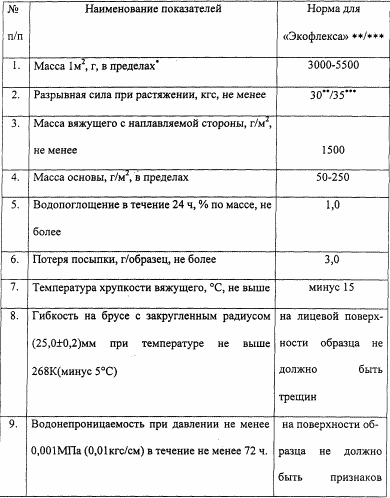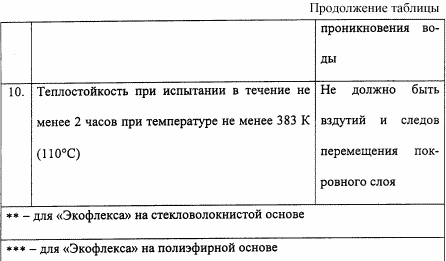| Start of section
Production, amateur Radio amateurs Aircraft model, rocket-model Useful, entertaining |
Stealth Master
Electronics Physics Technologies Inventions |
Secrets of the cosmos
Secrets of the Earth Secrets of the Ocean Tricks Map of section |
|
| Use of the site materials is allowed subject to the link (for websites - hyperlinks) | |||
Navigation: => |
Home / Patent catalog / Catalog section / Back / |
|
INVENTION
Patent of the Russian Federation RU2235817
![]()
ROLLING ROOF AND WATERPROOFING MATERIAL
"ECOFLEX" AND METHOD OF ITS RECEIVING
The name of the inventor:
The name of the patent holder: Closed Joint-Stock Company "Technonikol" (RU)
Address for correspondence: 450014, Ufa, ul. Mingazheva, 100, room 308, N.T. Suleimanov
The effective date of the patent: 2002.10.15
The method of obtaining a roll roofing and waterproofing material refers to the field of building materials intended for the construction of a roofing carpet of buildings and structures for various purposes. The method is more economical and technological due to the simplification of the composition of the binder layer. The method comprises the preparation of a bitumen-polymer binder, consisting of bitumen, a polymer component and a filler, treatment of the substrate in impregnating-coating baths at regulated temperatures, subsequent application of a coating or film and cooling, wherein atopic, isotactic polypropylene polypropylene is used to prepare the bitumen- Waste polyethylene production, filler and bitumen, mixing of components is carried out at 180-250 ° C, as a basis glass-fiber or polyester web is used and the temperature in the impregnating-cover bath is maintained in the range 145-155 ° C.
DESCRIPTION OF THE INVENTION
The invention relates to the field of building materials, namely to roofing and waterproofing materials intended for the construction of roofing carpets of buildings and structures for various purposes and waterproofing of building and other structures.
The main requirements for the material are:
- watertightness both in the case of water vapor from inside buildings and external moisture;
Bending resistance;
- strength - resistance to breaking loads.
The latter becomes very relevant in the construction of buildings with an original difficult-to-use roof, when used in hard-to-reach places of the roof. Actually, the expansion of the field of use of material for special purpose structures, for example transported sports facilities, playgrounds, stage. It is important in this case, while maintaining the properties of the material, a reduction in its thickness, which, first of all, reduces the weight of the structure.
The most promising are bitumen-polymer roofing materials, in which polymers are modified additives to improve the characteristics of bitumen. Glass fiber and polyester fibers can be used as a basis.
Bitumen-polymer roofing materials based on bitumen and rubber chips with additives of thermoplasticity are known [A. USSR № 1047939, C 08 L 95/00, 1983; As. USSR No. 1143754, C 08 L 95/00, 1985] and with the addition of styrene-butadiene rubber.
Known is the roll roofing material "Fizil", produced by JSC "Filykrovlya" Moscow (thickness 4.5 mm). Its basis is fiberglass, which is impregnated and coated on both sides with bitumen-polymer binder. The top layer has a coarse-grained mineral powder, the lower shallow, preventing coalescence of the roll. Bitumen-polymer binder consists of a mixture of unoxidized bitumen and divinyl styrene elastomer.
The following structure is also known in the following structure: the glass fiber reinforcement is impregnated and covered on both sides with a bitumen-polymeric binder layer consisting of bitumen, thermoplastic rubber, filler, followed by coating with a powder or Polymer film.
In order to improve the properties of the material, and to improve the compatibility of the polymer with bitumen, a modified bitumen-polymer composition is used, including low molecular weight polyethylene and atactic polypropylene, which are polyunsaturated carbohydrates and provide better solubility of the polymer.
Glass reinforcement is used as the reinforcing glass substrate, which is treated with sizing agent after removal of the lubricant. As a polymer film - polyethylene film thickness of 8-12 microns, as a powder - talc, sand.
The method of manufacturing the material in all the above cases includes mandatory operations:
1) preparation of bitumen-polymer binder layer;
2) treatment of the base in impregnating-coating baths;
3) application of a coating or film.
Despite the improved properties of the latter material, a further increase in moisture resistance remains an actual problem. Especially when exposed to an aqueous medium under pressure.
The object of the invention is to provide a material with a thickness of the order of 3 mm or less, providing further enhancement of watertightness and other characteristics such as bending resistance and breaking load.
The task is achieved by means of a roll roofing and waterproofing material in which the reinforcing base is impregnated and coated on both sides with a bitumen-polymer binder consisting of bitumen, a polymer component and a filler, followed by coating the substrate with a polymer film and / or using a powder. The bitumen-polymer binder layer has the following composition,%:
Polypropylene atactic (ALL) 3,5-5
Isotactic polypropylene (PPI) 1.5-2
Polyethylene production waste 0,5-1,5
Filler 35-40
Bitumen Others
In addition, a fiberglass or polyester web is used as the basis.
The task is also solved by a method for manufacturing a roll roofing and waterproofing material, comprising the preparation of a bitumen-polymer binder layer and treatment of the substrate in impregnating-coating baths at regulated temperatures, subsequent application of the coating or film and cooling. During the preparation of the bitumen-polymer layer, the components are mixed at a temperature of 180-250 ° C, and the temperature in the impregnating-cover bath is maintained at 145-155 ° C.
The optimal combination of the material components providing better solubility and compatibility of the polymer with bitumen and the modes of the method providing deep impregnation and bonding of the binder layer to the substrate allows to improve the material quality by increasing characteristics such as water resistance, bending resistance, Reducing the thickness of the material and its weight.
The invention is not explained with graphical materials. In describing the method, reference is made to standard, widely used equipment. In addition, the modes of the method are independent of the kind of substrate.
The method is carried out as follows.
The preparation of the coating material is carried out in three mixers of 10 m 3 each . The mixer consists of a body, a stirring device and a drive. Bitumen is piped to the mixer, after filling in 3/4 of the volume, polymers are fed: APP, after 30-40 minutes stirring, IPP and simultaneously granules (or film) of polyethylene waste are fed. The speed of rotation of the mixer when entering components should be 150 rpm. The dosage of all components is by weight to create a 4% ALL composition, 2.0% PPI, 1.5% polyethylene waste. Mixing of components is performed at a temperature of not less than 180 ° C for 1-2.5 hours. The temperature of the mixture is maintained by circulating the heat transfer oil at a temperature of 250 ° C through the mixer jacket. The ready-mixed coating mixture with a temperature of at least 180 ° C is pumped to a turbomixer of individual preparation over the unit, where a dosage of filler - talcomagnesite is 40%. Further, the finished coating mass by gravity flows into the impregnation-cover bath, where the temperature is maintained at 155 ° C.
The impregnating-covering bath is designed to impregnate the substrate and apply a top layer to its surface from above and below.
The bath consists of the following components: frame, guide roller, immersion device, squeezing rollers, deflection roller, calibration device, two spreading rollers, scraper and two drives.
The bath works in a circulating mode, thus stabilizing the temperature of the masses in the bath is achieved.
The base sheet from the device of the axial wiring is fed to the guide roll of the bath, the roller of the submerged device directs it to the impregnating mass, where the web is impregnated. The impregnated web rises upward, passes between the pressing rolls, where an excess of impregnating paste is removed from it. Then the canvas rises up on the deflecting roll, bends around it and the immersion roller of the calibration device is again lowered into the bath, but already into the cover mass. While the impregnated web passes the path from the pressing rolls to the cover mass, moisture is evaporated from it, while the web is partly cooled, creating favorable conditions for the adhesion of the impregnating and covering masses. From the coating weight, the web rises to the first spreading roll and passes the calibration gap between the spreading roller and the calibration roller. At the same time, the roller aligns the cover layer on top of the web, and the spreading roller increases the thickness of the coating layer from the bottom of the web. The web is fed to a second spreading roll that increases the cover layer from the bottom of the web and passes the tubular scraper where its lower cover layer is leveled, if necessary its excess is removed, and the side scrapers align the edges of the web.
Pre-cooling the canvas is carried out in a water bath.
The bathtub is a rectangular tank mounted on racks with adjusting screws, with which you can change the position of the bath in height.
After application of the coating composition, the web enters the water bath, where due to the contact of the lower layer of the web with running water, its partial cooling takes place.
On the exit from the water bath the canvas enters the spray application unit.
The application site for the powder, protective and edge film is intended for application to the material depending on the edge film type, protective polyethylene film from the lower and upper sides or only from the lower, coarse or fine-grained sprinkling, selection and return to the appropriate hoppers of spilling surpluses of powder and partial cooling Finished material.
The application site for the coating and film consists of coarse-grained and fine-grained powder dispensers, a mechanical cleaning system and return of surplus powder.
When applying the powder, the partially cooled web passes through the top side, on which the edge film is applied at least 100 mm wide, under the coarse-grained powder hopper, while the rotating corrugated roller continuously feeds onto the moving web. Excess of the powder by the mechanical cleaning system is returned to production. To increase the adhesion strength of the grains of the powder with the cover layer, rolls are used which are installed on one of the refrigerating cylinders. Then the canvas is covered from the lower side with a protective polyethylene film or fine-grained powder. Qualitative indicators of the material are given in the table.
 |
 |
CLAIM
A method of manufacturing a roll roofing and a waterproofing material, comprising the preparation of a bitumen-polymer binder consisting of bitumen, a polymer component and a filler, treating the substrate in impregnating-coating baths at regulated temperatures, then applying a coating or film and cooling, characterized in that for the preparation of bitumen -polymeric binder is used, by mass%:
Polypropylene atactic APP 3,5-5
Isotactic polypropylene PPI 1.5-2
Polyethylene production waste 0,5-1,5
Filler 35-40
Bitumen Others
Mixing of the components is carried out at 180-250 ° C, a fiberglass or polyester web is used as the base, and the temperature in the impregnating-cover bath is maintained in the range of 145-155 ° C.
print version
Date of publication 01/18/2007




Comments
When commenting on, remember that the content and tone of your message can hurt the feelings of real people, show respect and tolerance to your interlocutors even if you do not share their opinion, your behavior in the conditions of freedom of expression and anonymity provided by the Internet, changes Not only virtual, but also the real world. All comments are hidden from the index, spam is controlled.